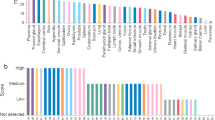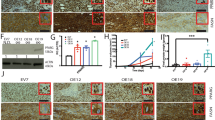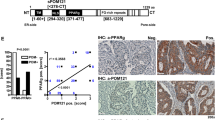Abstract
BRCA1 has been linked to the genetic susceptibility of a majority of familial breast and ovarian cancers. Several lines of evidence indicate that BRCA1 is a tumor suppressor and its expression is downregulated in sporadic breast and ovarian cancer cases. Therefore, the identification of genes involved in the regulation of BRCA1 gene expression might lead to new insights into the pathogenesis and treatment of these tumors. Peroxisome proliferator-activated receptor gamma (PPARγ) is a member of the nuclear receptor superfamily that has well-established roles in the regulation of adipocyte development and glucose homeostasis. More recently, it has been shown that ligands of PPARγ have a potent antitumorigenic activity in breast cancer cells. In the present study we have found that two distinct ligands of PPARγ; 15-deoxy-Δ-12,14-prostaglandin J2 (15dPG-J2) and rosiglitazone, increase the levels of BRCA1 protein in human MCF-7 breast cancer cells. Immunofluorescence microscopy analysis showed that, after treatment with 15dPG-J2, the BRCA1 protein is mainly localized in the nucleus. Functional analysis by transient transfection of different 5′-flanking region fragments, as well as gel mobility shift assays and mutagenic analysis, suggests that the effects of 15dPG-J2 and rosiglitazone are mediated through a functional DR1 located between the nucleotides −241 and −229, which is a canonical PPARγ type response element. Our data suggest that PPARγ is a crucial gene regulating BRCA1 gene expression and might therefore be important for the BRCA1 regulatory pathway involved in the pathogenesis of sporadic breast and ovarian cancer.
This is a preview of subscription content, access via your institution
Access options
Subscribe to this journal
Receive 50 print issues and online access
$259.00 per year
only $5.18 per issue
Buy this article
- Purchase on Springer Link
- Instant access to full article PDF
Prices may be subject to local taxes which are calculated during checkout




Similar content being viewed by others
References
Aranda A and Pascual A . (2001). Physiol. Rev., 81, 1269–1304.
Baer R and Ludwig T . (2002). Curr. Opin. Genet. Dev., 12, 86–91.
Budhram-Mahadeo V, Ndisang D, Ward T, Weber BL and Latchman DS . (1999). Oncogene, 18, 6684–6691.
Castrillo A, Diaz-Guerra MJ, Hortelano S, Martin-Sanz P and Bosca L . (2000). Mol. Cell. Biol., 20, 1692–1698.
Catteau A, Harris WH, Xu CF and Solomon E . (1999). Oncogene, 18, 1957–1965.
Chen Y, Chen CF, Riley DJ, Allred DC, Chen PL, Von Hoff D, Osborne CK and Lee WH . (1995). Science, 270, 789–791.
Fan S, Ma YX, Wang C, Yuan RQ, Meng Q, Wang JA, Erdos M, Goldberg ID, Webb P, Kushner PJ, Pestell RG and Rosen EM . (2001). Oncogene, 20, 77–87.
Fan S, Wang J, Yuan R, Ma Y, Meng Q, Erdos MR, Pestell RG, Yuan F, Auborn KJ, Goldberg ID and Rosen EM . (1999). Science, 284, 1354–1356.
Forman BM, Chen J and Evans RM . (1996). Ann NY Acad. Sci., 804, 266–275.
Forman BM, Tontonoz P, Chen J, Brun RP, Spiegelman BM and Evans RM . (1995). Cell, 83, 803–812.
Harkin DP, Bean JM, Miklos D, Song YH, Truong VB, Englert C, Christians FC, Ellisen LW, Maheswaran S, Oliner JD and Haber DA . (1999). Cell, 97, 575–586.
Jiang C, Ting AT and Seed B . (1998). Nature, 391, 82–86.
Lebovitz HE and Banerji MA . (2001). Recent. Prog. Horm. Res., 56, 265–294.
MacLachlan TK, Somasundaram K, Sgagias M, Shifman Y, Muschel RJ, Cowan KH and El-Deiry WS . (2000). J. Biol. Chem, 275, 2777–2785.
Mancini DN, Rodenhiser DI, Ainsworth PJ, O'Malley FP, Singh SM, Xing W and Archer TK . (1998). Oncogene, 16, 1161–1169.
Menendez-Hurtado A, Santos A and Perez-Castillo A . (2000). Endocrinology, 141, 4164–4170.
Mueller E, Sarraf P, Tontonoz P, Evans RM, Martin KJ, Zhang M, Fletcher C, Singer S and Spiegelman BM . (1998). Mol Cell, 1, 465–470.
Nathanson KL, Wooster R, Weber BL and Nathanson KN . (2001). Nat. Med., 7, 552–556.
Picard F and Auwerx J . (2002). Annu. Rev. Nutr., 22, 167–197.
Pignatelli M, Cortes-Canteli M, Lai C, Santos A and Perez-Castillo A . (2001). J. Cell. Sci., 114, 4117–4126.
Rosen ED and Spiegelman BM . (2001). J. Biol. Chem., 276, 37731–37734.
Scully R, Ganesan S, Brown M, De Caprio JA, Cannistra SA, Feunteun J, Schnitt S and Livingston DM . (1996). Science, 272, 123–126.
Straus DS, Pascual G, Li M, Welch JS, Ricote M, Hsiang CH, Sengchanthalangsy LL, Ghosh G and Glass CK . (2000). Proc. Natl. Acad. Sci. USA, 97, 4844–4849.
Suen TC and Goss PE . (1999). J. Biol. Chem., 274, 31297–31304.
Thakur S and Croce CM . (1999). J. Biol. Chem., 274, 8837–8843.
Thomas JE, Smith M, Rubinfeld B, Gutowski M, Beckmann RP and Polakis P . (1996). J. Biol. Chem., 271, 28630–28635.
Thompson ME, Jensen RA, Obermiller PS, Page DL and Holt JT . (1995). Nat. Genet., 9, 444–450.
Wang A, Schneider-Broussard R, Kumar AP, MacLeod MC and Johnson DG . (2000). J. Biol. Chem., 275, 4532–4536.
Wilson CA, Ramos L, Villasenor MR, Anders KH, Press MF, Clarke K, Karlan B, Chen JJ, Scully R, Livingston D, Zuch RH, Kanter MH, Cohen S, Calzone FJ and Slamon DJ . (1999). Nat. Genet., 21, 236–240.
Xu CF, Chambers JA and Solomon E . (1997). J. Biol. Chem., 272, 20994–20997.
Acknowledgements
This work has been supported by grants from the Dirección General de Enseñanza Superior e Investigación Científica, Grants BMC2001-2342 (APC) and PM99-0057 (AS) and by the Comunidad de Madrid, Grant 08.5/0078/2000 (AS). MP is a fellow of the Fondo de Investigaciones Sanitarias de la Seguridad Social.
Author information
Authors and Affiliations
Corresponding author
Rights and permissions
About this article
Cite this article
Pignatelli, M., Cocca, C., Santos, A. et al. Enhancement of BRCA1 gene expression by the peroxisome proliferator-activated receptor γ in the MCF-7 breast cancer cell line. Oncogene 22, 5446–5450 (2003). https://doi.org/10.1038/sj.onc.1206824
Received:
Revised:
Accepted:
Published:
Issue Date:
DOI: https://doi.org/10.1038/sj.onc.1206824
Keywords
This article is cited by
-
Thermodynamics in cancers: opposing interactions between PPAR gamma and the canonical WNT/beta‐catenin pathway
Clinical and Translational Medicine (2017)
-
Opposing roles for mammary epithelial-specific PPARγ signaling and activation during breast tumour progression
Molecular Cancer (2015)
-
microRNA alterations in ALDH positive mammary epithelial cells: a crucial contributing factor towards breast cancer risk reduction in case of early pregnancy
BMC Cancer (2014)
-
Adipositas und Karzinogenese des Mammakarzinoms
Der Gynäkologe (2010)
-
Adipocyte fatty acid-binding protein as a novel prognostic factor in obese breast cancer patients
Breast Cancer Research and Treatment (2010)



